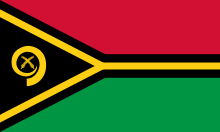Malo Island
| Malo Tamambo | |
|---|---|
| Island | |
 Malo Location in Vanuatu | |
| Coordinates: 15°41′S 167°10′E / 15.683°S 167.167°ECoordinates: 15°41′S 167°10′E / 15.683°S 167.167°E | |
| Country |
|
| Province | Sanma Province |
| Area | |
| • Total | 180 km2 (70 sq mi) |
| Population (2009) | |
| • Total | 4,273 |
| • Density | 24/km2 (61/sq mi) |
| Time zone | VUT (UTC+11) |
Malo (formerly known as St. Bartholomew) is an island in Vanuatu, 3 km (1.9 mi) off the southern coast of Vanuatu's largest island Espiritu Santo in Sanma Province.[1] It has a circumference of 55 km (34 mi) and an area of 180 km2 (69 sq mi).
Geography
Like most of Vanuatu, the island is of volcanic origin. The highest point on the island is Malo Peak, at 326 m (1,070 ft) above sea level.[2]
The main products of the island are copra and cocoa grown on plantations.[1]
Demographics
In 1979, the island had a population of 2,312. The 1999 census found a population of 3,532. By the 2009 census, the total population had grown to 4,273, an increase of 21% since 1999.[3] Avunatari (Abnetare), the main center on the northwest coast, had 600 people in 1999.
There are two main cultural groups on the island of Malo, the cultural group of Auta that inhabits the western part of the island as well as the cultural group of Tinjivo that inhabits the eastern portion of the island. Both these cultural group speak a variant of the Tamambo language. Malo is also the name of the Austronesian language spoken on the island.
The earliest archaeological evidence of human habitation in Vanuatu is from a site on Malo that was settled circa 1400 BC. Artifacts from this early settlement are characteristic of the Lapita culture.[1][4]
References
- 1 2 3 John Seach. "Malo Island, Vanuatu". Vanuatu Travel. Retrieved 2012-02-18.
- ↑ Siméoni, Patricia (2009). Atlas du Vanouatou. Port-Vila: Éditions Géo-consultre. p. 31. ISBN 978-2-9533362-0-7.
- ↑ 2009 National Census of Population and Housing Summary Release, Port Vila, Vanuatu: Vanuatu National Statistics Office, 31 August 2009, retrieved 23 February 2012
- ↑ Michelle Bennett; Jocelyn Harewood (September 2003). Vanuatu. Lonely Planet. p. 11. ISBN 978-1-74059-239-0. Retrieved 2012-08-11.
The earliest evidence of human occupation in Vanuatu comes from a site on the island of Malo, first settled in about 1400 BC by people of the Lapita culture.
| Wikimedia Commons has media related to Malo Island. |
